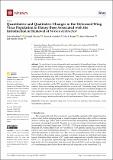Quantitative and qualitative changes in the Deformed wing virus population in honey bees associated with the introduction or removal of Varroa destructor
Abstract
Varroa destructor is an ectoparasitic mite associated with significant losses of honeybee colonies globally. The mite vectors a range of pathogenic viruses, the most important of which is the Deformed wing virus (DWV). In the absence of Varroa, DWV exists as a low-level, highly diverse virus population. However, when transmitted by Varroa, certain variants become highly elevated, and may become near-clonal and cause symptomatic infections. Mite transmission between colonies can occur when parasitised workers drift from or rob adjacent hives. These activities can result in elevated mite levels, but the resulting change in the DWV population, the primary determinant of winter colony losses, has not been determined. In reciprocal studies, we investigated the influence of the removal of mites, or their acquisition, on the DWV population. When mites were removed from heavily infested colonies, there was a striking and rapid reduction in virus load. Conversely, siting Varroa-naïve colonies in a mite-infested apiary resulted in the acquisition of mites and concomitant changes in the virus population. We observed both near-clonal and highly divergent virus populations regardless of titre, suggesting changes were stochastic and colony-specific. Our findings have implications for the outcome of strategies in areas with total or patchy implementation of Varroa control plans.
Citation
Woodford , L , Christie , C R , Campbell , E M , Budge , G E , Bowman , A & Evans , D J 2022 , ' Quantitative and qualitative changes in the Deformed wing virus population in honey bees associated with the introduction or removal of Varroa destructor ' , Viruses , vol. 14 , no. 8 , 1597 . https://doi.org/10.3390/v14081597
Publication
Viruses
Status
Peer reviewed
ISSN
1999-4915Type
Journal article
Description
Funding: This research was funded by the BBSRC (Biotechnology and Biological Sciences Research Council), grant number: BB/M010996/1 and BB/S008705/1 (http://www.bbsrc.ac.uk ). C.R.C. was part-supported by a KTN BBSRC CASE studentship BB/M503526/1. EMC was supported from the European Union’s Seventh Framework Programme for research, technological development and demonstration under grant agreement no 613960 (SMARTBEES - (http://www.smartbees-fp7.eu).Collections
Items in the St Andrews Research Repository are protected by copyright, with all rights reserved, unless otherwise indicated.

